At the recent edition of Watches & Wonders, IWC Schaffhausen introduced a significant timepiece to the brand.

The Ingenieur Automatic 40 is a watch inspired by Gérald Genta’s Ingenieur SL, Reference 1832, from the 1970s, reflecting the iconic design codes and bold aesthetic of the watch, encompassing three new editions that bring the iconic design into the 21st century. The new Ingenieur is powered by the IWC-manufactured 32111 calibre with a power reserve of 120 hours. All new models feature soft-iron inner cases to protect the movements from magnetic fields and are water-resistant to 10 bars, making them fully versatile sports watches for the 21st century. With a successful reaction to the watch so far, it’s set the brand up for an exciting year ahead. We talk to CEO Christoph Grainger-Herr to find out more.

Watches & Wonders 2023
Tell us about the experience at this year’s Watches & Wonders – how did the event serve the brand, and what was the feedback?
We had a fantastic Watches & Wonders this year, and it was one of the most significant evolutions in watches & Wonders I can remember. We’ve been doing these events for sixteen or seventeen years now, and it’s fantastic to see how it’s developed; when you look at the feedback and visitor numbers this year, it’s been by far the most frequented Watches & Wonders. We had a huge influx of visitors from all over the world which, and it was interesting seeing the watch industry come together in this way, especially after the concept of physical fairs has been constantly questioned since the pandemic. The resurgence of attendance we experienced this year proves the importance and relevance of these kinds of events.
Watches & Wonders was open to the public for the first time this year, it was completely sold out, and I was blown away by not only the interest and the feedback of people travelling from all over Europe and beyond but also how they were interested in the products and making inquiries and I think that’s a fantastic step forward for Watches & Wonders. So as an exhibitor, we couldn’t be happier.
For us, this year was quite a key moment because after many years of waiting to re-enter the integrated steel sports market with the Ingenieur, we brought back one of the three original Gérald Genta designs, and to receive the sort of feedback we’ve had so far, has felt very special. So, it was a very focused edition of Watches & Wonders for us. We presented several new automatic models in the Ingenieur line, three in stainless steel, and one in titanium, so it’s hyper-focused, but it was interesting to see the clarity of the message and how it was received. It’s not a confusing storyline across many families; it’s one story about the heritage, engineering, and design of this watch and how to distil what is essentially the DNA of the watch and turn it into a relevant product. That’s been the storyline of the launch, and it’s been fantastic.

Watches & Wonders 2023
How have you taken the original design of the Ingenieur Automatic and made it relevant today, and what were the challenges?
The Ingenieur is such a unique piece because it has had many iterations throughout its history and lifetime; from the start, in the 1950s, we had an antimagnetic watch with a very classical design. And then, in the sixties and early seventies, we saw this idea of a sports watches emerge from what was previously a classically designed gold watch; all of a sudden, Quartz came in, and a new aesthetic had to be found that went beyond very classical golden watches and that’s really why Gérald Genta jumped onto the trend at the time, reformulated what a luxury mechanical watch could be. He created bold sporty designs using stainless steel, not precious metal, with an openly expressed construction and a much bolder look and feel to these products. The Ingenieur first appeared in 1976 and from there, went through many different iterations; in fact, many of the watches that are now revered as the original designs were never manufactured. There was not a completely continuous design solution from the beginning; there were a lot of disruptions along the way.
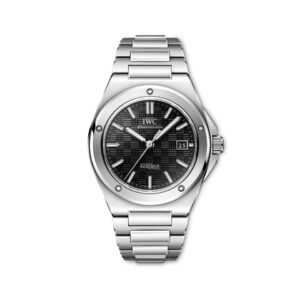
Ingenieur Automatic
Everyone in the watch world and everyone familiar with IWC and Gérald Genta might happily agree that we should bring back the Ingenieur, but we had to look at what that means. Although the design DNA of the Ingenieur is strong, the design translation of the original was neither very wearable nor was it appropriate for today in terms of proportion. So we could not just go back to the original design; an evolution had to happen in terms of case size, height, ergonomics, the way the watch sits on the wrist, the pure wearability, and also making sure the proportions were modernised. The original watch had quite a dominant bezel but was flat with a wide integrated band that looked like a thick bracelet. We decided to maintain the dominance of the bezel but trim down the integrated steel bracelet to make sure it flows over the wrist properly and fits different wrist sizes. We created a more modern balance between case and bracelet. Of course, we wanted to maintain the anti-magnetism, so the new Automatic also has a closed caseback and antimagnetic protection. We have a proper three-piece case construction with a screw-in bezel that is not just decorative but functional. We invested in the bracelet design to ensure that we have a high-end stainless-steel bracelet with the best ergonomics, really good stability. We invested a lot in the finishing to ensure that it’s a product that is at the level of what Gérald Genta intended, but at the same time, is a wearable modern sports watch. Gérald’s wife, Evelyne Genta, has endorsed the watch, and we have support from the family foundation, which is fantastic. Evelyne was involved in the design discussions to give her input and for her to say that this is how Gérald would have done it, and that’s really special and a nice touch to round off the story.

Ingenieur Automatic
Now we have the core model and the essence of the design; we will go from there and continue to develop this line. It’s been fantastic to hear the feedback from both men and women around this watch, and it has given me the confidence that we can build something from this.
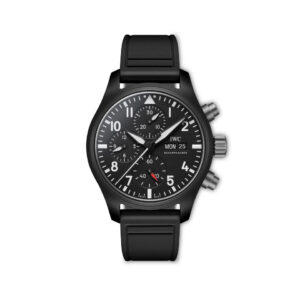
Pilot’s Watch
We also saw some new references on Pilot’s Watches within the Top Gun line; what can you tell us about that and why the Pilot’s line, in general, is still such an important pillar for the brand?
Generally speaking, there has been a long-term trend around this appetite for sports watches over the last five or six years, particularly colourful sports watches. We’ve seen a return to the happier, more playful side of watchmaking, especially after the pandemic. We’ve seen boasts of colour, playful associations and so on. Starting from the original straightforward tool watch in the Pilot’s classic designs, in 2019, we embarked into the field of coloured ceramics. That has really appealed to people looking for this slightly more expressive and playful twist on the classic. When you think about aviation-inspired contemporary sports watches, IWC is the reference in that field, and from there on, we’ve found that people love this uniqueness that we bring in colour codes such as the Mojave Desert watch, which is different from anything else in the industry. This watch has a functional background, but at the end of the day, it becomes a contemporary sports watch that is a style choice more than anything else. Then we added the Lake Tahoe-coloured crisp black and white edition, showing the graphic quality of the Pilot’s design so well. The white against the black turns it into the purest expression of that particular design code. I always thought this watch would be more of a niche choice, but it turned out it wasn’t at all! People were jumping onto ceramic watches, and we totally underestimated the response. Last year we introduced the Woodland Green shade, and the latest is the Oceana Blue which we presented at Watches & Wonders.

Oceana Blue
This watch has a new diameter of 41cm. We kept wearability in mind, and there is definitely a place for two diameters in our line-up. The Oceana is a watch I have been wearing often, especially around the pool. It has a denim inlay rubber strap which is waterproof, sun cream proof and UV-proof. And again, the versatility of a blue and white watch is something that really works. It was a bit of a dark horse in terms of our launches at Watches & Wonders, but once you have it on your wrist, you don’t want to take it off. That is, for me, a good indicator. Ultimately watches are a personal preference; you must like wearing them and feel an emotional connection to them. There are many watches that I like to look at from afar, but on my own skin, they are not comfortable, and that’s why when customers ask me for advice, I tell them it’s such a personal choice. Of course, I can give direction, but ultimately the only thing that matters is that they feel good in the watch and that it brings them joy when they wear it. Quite often, the watch that you might have thought you would like on paper is not the watch for you, and I think that’s what makes our products so unique; it’s a very personal experience.
Do you think the physical boutique experience is still relevant to customers today?
My background is in-store architecture, so I am a little biased, but when all the other channels started to emerge, from around the late noughties – it really took off around 2017 – it also took us a while to work out what the online shopping experience for luxury watches looked like. There must be a balance between the convenience of online shopping, personal advice, and a seamless luxury experience. But I never thought this would ever be anything but a complimentary channel, a tool to meet a certain customer need. Luxury brands are all about the emotional experience, the meaning, the heritage, the character and ultimately, what the brand expresses. Online shopping has shifted towards a very straightforward convenience factor. When you enter a brand’s website, you don’t have to navigate through tonnes of immersive experience videos until you get to the products, it’s more simple, convenient, and information-driven and that only takes you so far. When buying a non-essential, emotional product, especially from a certain price point and above, I feel customers what to know what the brand is, who’s behind it, where it’s from, what it represents and whether they trust it with a lot of their hard-earned money. And this is where the physical experience starts to come in and where physical advertising, stores and human interaction are such an important part of buying that type of product. And that’s why I think, despite all of the growth online, I don’t believe that you can fully virtualise a luxury brand. I think humans are fundamentally wired to want that human aspect. The virtual part is there for research and to obtain or buy something quickly when the occasion arises. But it is always complementary to the physical experience.

Lewis Hamilton
How important is it for you as a brand to be creating experiential moments for your clients?
The way that it works for luxury brands and for us is that we want to offer an almost infinite number of layers of interaction, involvement, and relationship to our customers. As you get invested into a brand as a client, it is more important. As luxury watch brands, we are quite particular in the sense that we’re somewhere between being a fashion brand and being an enthusiast technical brand. So, on the one hand, you have that style and status element; on the other hand, you have huge technical complexity, craftsmanship, and heritage, and some of our customers really want to dive into that. So, you must have layers that appeal to all types of customers. To be able to understand a brand from the very public and in a way superficial image and representation is one part, but then you have experiences that go beyond that. Moments where you could interact with a brand to understand its DNA a lot better, and then you start to create a personal relationship with the people behind the brand. When we have intimate events with our customers, the takeaway is that the customers understand more about the brand and why we work with the people we do. Of course, we can’t invite all our customers to these events, but as you get more familiar with the brand, you want to understand more. You want to come to the factory and start finding out what it’s like to build a watch. You want to meet the people behind it, and I think our job is to create a multi-layer platform where you go from a basic understanding of the brand to the very top level, where you become part of the family.
Digital innovation has allowed us to bring a deeper experience of our brand to many more people than before, and that’s been a huge development we’ve seen over the past few years. This adds a layer of involvement that didn’t exist before, reaching a completely different audience than traditional media. It shows how we can bring diverse sets of people into a conversation or interaction, and that’s what we are working on more of. As new things emerge, my approach is always to be part of it early on and experiment, and we know that things aren’t always going to take off, but we are always open to experimenting.
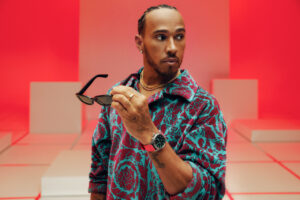
Lewis Hamilton
We know that partnerships and ambassadors are key for the brand – tell us more about that, and what do you look for when entering these kinds of partnerships?
The best way for me to explain our relationship with our partners and ambassadors is to take the example of Lewis Hamilton, who has now been working with us for ten years. When you think about the evolution of Lewis Hamilton and the evolution of the awareness of Formula One around the world across generations, it’s nothing short of amazing for me. You have somebody who started with McClaren at a very young age before joining Mercedes in 2013, and we have now just celebrated ten years of partnership with the team and with Lewis. Over this time, we’ve done everything from awareness of social issues to straightforward campaigns, comedy videos, customer interactions, acting, music – you name it, we’ve done it! Lewis is such a great ambassador for the sport and, the values he represents and his investment in diversity anti-racism. Everything he represents is a powerful association for IWC to show what we stand for and who we are. Again, talking about layers, he’s somebody who, as an ambassador, will bring awareness to the brand, especially to young people. The increase in Lewis Hamilton awareness now in the United States is insane. There is an unbelievable platform that you can’t replicate without someone with that sort of reach. Just recently, we had a fantastic basketball activation in Miami where Lewis came out and all of the children from the Dibia DREAM non-profit organisation joined in. Yes, it created huge PR coverage, but at the same time, that charity effect on the local community was great for them and our customer engagement. Lewis is an absolute star when he meets any of our customers. He takes time to talk to them all and to see, after ten years of partnership, the level of trust that’s there and how relaxed he is when he approaches all of the things we do together, that’s something that radiates to the millions of young new followers of Formula One who will be coming into contact with our brand for the first time, all the way to our top customers who might own a Lewis Hamilton Special Edition watch who have the pleasure to meet him through these events. It’s these moments when he really engages with people and answers questions that we see the real benefits of these partnerships and our layers that can be highlighted through the experiences with our ambassadors. We are fortunate to have these kinds of long-term partnerships.
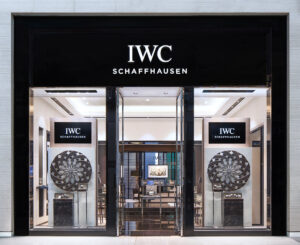
IWC Schaffhausen boutique The Dubai Mall, Dubai
Tell us about IWC in the Middle East and your focus for the region this year.
The development of the region has been absolutely amazing in recent years. I think we’ve seen the interest in luxury watches rapidly accelerate recently. I remember when the Dubai Mall was constructed, and nobody could have foreseen what sort of development it would take. But it is today probably the most important shopping mall in the world. I think the traffic our store in the Dubai Mall generates is crazy. Since we moved into a bigger, more experiential space, it is one of our leading boutiques in the world. And therefore, the quality of the environment and our customers from all regions of the world is a special blend in Dubai. I love the energy, and it’s a real pleasure.
This year we have a main launch coming in the autumn, which we are looking forward to, and we will be activating that around that in the Middle East. Quite a number of store openings are happening around the region beyond the UAE. It’s a fantastic region for watches.
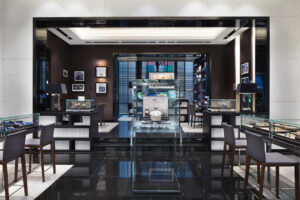
IWC Schaffhausen boutique The Dubai Mall, Dubai
What message would you send to your clients and friends here in the Middle East?
I love that celebrating watchmaking in the Middle East, in many cases, brings together a diverse mix of people, and this exchange of ideas, viewpoints, and tastes is what really needs to be celebrated. We are in a time where many discussions around public life are quite polarising, and we see a lot of trends of things drifting apart, to experience places in the world where people come together peacefully is so important. It’s so important to have things like watchmaking in regions like Dubai where people can connect and come together with their shared passion.















